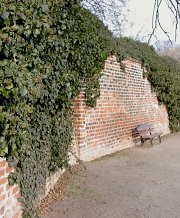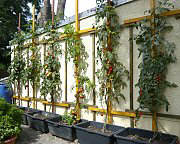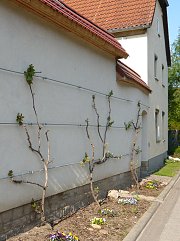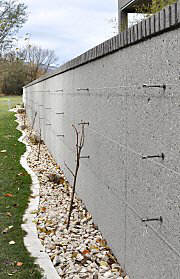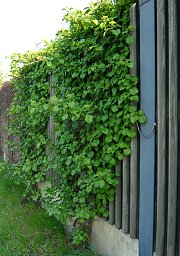Greening a Wall (free-standing / non load-bearing)
Non load-bearing (free-standing) walls, wall panels, partitions, retaining walls, etc.. can also be transformed into facade gardens, but the approach will be slightly different than the usual facade greening. This begins with the question of whether or not you want to cover the entire wall up to the wall coping, and whether the greenery shall be overhanging, etc.. Here you'll find examples of this type of wall greening, from historical garden walls to modern retaining walls and sound barriers. More about this topic under supporting/retaining walls, dry masonry, and gabions.

Greening with Self-Climbing Plants
'Self climbers' ~ like wild vine and ivy (Boston and English ivy) ~ for which climbing aids are unnecessary, are often used on such walls. When using these plants, however, it is particularly important that the wall is intact. The cope of the wall must be able to repel and drain all precipitation so that no water can penetrate from above, and all joints should be watertight so that the shoots of the plants cannot climb their way in (and cause potential damage to the structure). Climbing hydrangea and climbing spindle (winter creeper) are also suitable and less aggressive.
Walls with Espalier Fruit
This is the classic way of wall greening! Espaliers are trees that are given a strict shape to optimise space. In cooler areas of Central Europe, many plants love the stored warmth of a protective wall. They were traditionally planted at the foot of a stone wall, as the heat stored by the stones allows the fruit to ripen better. In the Baroque period, wall gardens with "talut walls" (free-standing roofed walls) were specially created to produce trellis fruits. Wooden trellises and horizontally spanned wire arrangements were also used; the latter inspired our cable system 8010.

Greening of an old 'talut wall' with grapevines

Peach and other trellis fruit on three horizontal wire-ropes

Grapevine on a wall

Vine cultivated as a horizontal cordon
Climbing Supports on Walls
Climbing support is required for almost all plants except for ivy and 'wild vines' like Boston ivy or Virginia creeper. Cable systems from FassadenGrün can also be used on non load-bearing walls; especially fitting are the elongated forms 8010and 8020. When necessary, several cable systems (such as 4010, 4020, or those from the 6000 category) can be grouped next to each other.
When mounting into natural stone masonry or brick, keep a 20 cm distance from all edges to prevent cracking. For more information, refer to our manual on 'drilling work for climbing aids'. Even in the range of 25 – 40 cm spacing on such walls, mounting should be done expansion-pressure free ~ so, no rawl plugs/dowels. Use composite mortar instead.
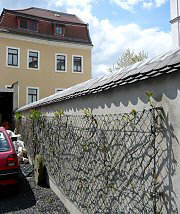
Thicket creeper budding, trellis made of wire netting/mesh.

Clematis on cable system 5050

Clematis on vertical wall protrusions, trellis cable system 4010

Espalier fruit on wire rope system 8010

Cable arrangement similar to our system 8020

Climbing hydrangea on cable analogous to our 1020
Modern Walls and Materials
Modern walls ~ usually made of concrete or precast concrete elements ~ lend themselves well to greening. Installing cable systems is easier than with older walls. There is a lower risk of cracking the wall at the cope and edges, and less risk of climbing plant tendrils crawling into the masonry.
Sound walls at the edge of motorways are prime candidates for greening. Climbing plants make the unsightly presence of these walls more bearable in the urban landscape. When all factors ~ a rapid wall growth coverage, evergreen vegetation growth, minimal maintenance, low water requirement, inexpensive or no climbing aid ~ cannot be reconciled, priorities must be set. The planting then complies with these factors. There are even scientific studies and long-term experiments on the greening of sound barriers. Please note the information under supporting walls, as well as dry stone wallsand gabion.

Evergreen honeysuckle, similar to our system 4030; object greening of a concrete wall

Ivy on cable system 8050

Ivy, cable-system for inserting and interweaving, similar to our system 5030

Greening with grapevines; retaining wall made of “L” elements, system 8010

Sound barrier wall with Veitchii (Japanese creeper/Boston ivy-- self-climbing)



